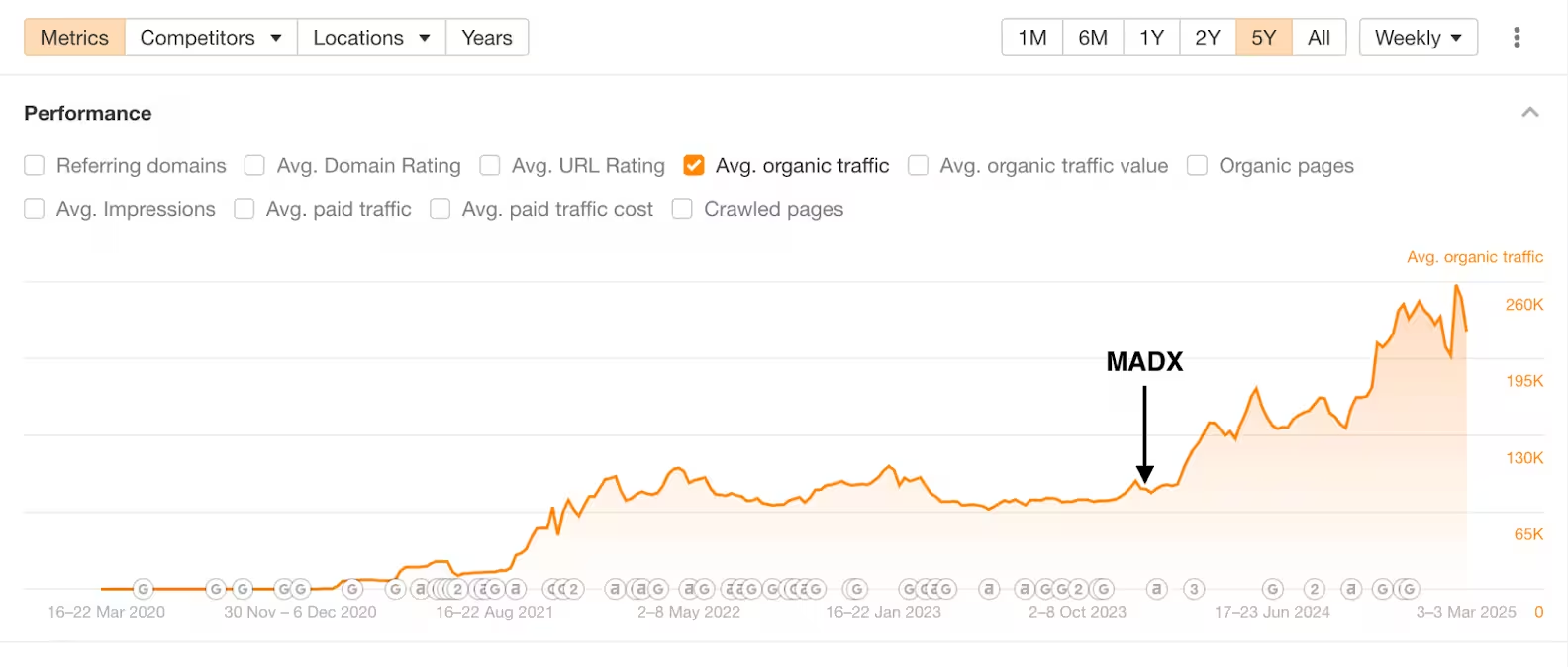This article is an excerpt from the Content Factory, a book on content marketing and building audiences in 2021.
The book is available on Amazon for $23. But it can be yours today for FREE. Continue reading, and request your free copy at the bottom.
What we’ll cover:
Deliver quality content at scale
Following a simple article structure helps writers deliver quality at scale.
I’m regularly publishing with Better Marketing, Startup, Ascent, and lately, off-medium outlets like Business Insider and even sharing my thoughts with Carol Roth’s website.
Here’s what helps deliver hundreds of articles a month.
Get the reader from point A to point B with as little fluff as possible.
- Find SEO questions
- Who are you writing for?
- Outline: Benefit? How-to? Examples? Conclusion?
- Read, watch, listen.
- Write.
1. Find SEO questions (~7min)
I’m using Semrush, Moz, and Ahrefs to dig out real interest. SEO is less about finding the right keywords and more about finding the right people. SEO is people.
If you identify a strong search volume for the term “staycation” while writing about the camping sites in the UK, you may want to answer that question in your story. Quick keyword research should give you a general taste of what the broad audience wants to read about.
If your reader has a good experience consuming the content, Google will be your friend. Focus on delivering the good stuff.
2. Who are you writing for? (~3min)
Imagine your reader as a person. Please invite them for coffee and jot down a few key points about their interests. Do they live fast? Do they like fresh coffee in the morning? Do they lift weights? Are they a Medium subscriber?
Have a friendly meta-chat with an imaginary reader. Friendly chats translate to writing and help writers strike a conventional tone.
3. Article Template (~2min)
I used to sit behind a computer and just write with a vague sense of direction.
I had a general 3-act sonata structure in mind, which brings exposition, development, and recapitulation. Sonata is a great outline for a blog article. Introduce your topic in the exposition, explain the promise in the development, and recapitulate an altered version of the exposition. Boom. Your story is ready for editing rounds.
This general structure is fantastic, but it can be a vague outline for many writers.
This batch of questions halved the time it takes to write a story.
- What is the benefit for the reader? Start in the middle of the action. Share the benefit of your story and include one example of proof. Keep it under 200 words, if possible.
- What is the topic you’re writing about? Articles that start with the question of what often can come off as dull, and textbookish. Readers usually still want to know what is it they’re reading about.
- How to deliver the promise? Explain your ideas. Include actionable steps, offer examples, and sprinkle more stats, proving your point.
- What are reader takeaways? Focus on the benefit and results. Tie the story together with the main points from the introduction, and summarize the actionable steps.
Write down the questions, and if you have any SEO questions, bum those inside too. Writing the questions down shouldn’t take long. Ideally, start with a document template.
4. Read, watch, listen (~15min)
Research is tricky. Internet is a distraction machine that will leave you binge-rewatching RuPaul's greatest moments, and you won’t even know how you got there. Beware. Self-discipline plays a key role in good research.
Individuals use limiting browsers and tossing your phone away helps. Walls and doors are fantastic productivity tools.
Take 15min for this step. Stay on top of your game, and don’t forget your objective — research template questions.
Google each question if you’re in a hurry. Otherwise, find interviews, read stories, watch YouTube, and even find podcasts. The best research comes from casual content consumption outside the writing research. You can refer back to a specific exchange from a podcast, video, or article when you’re researching a specific topic.
Your experience can is a great veil of inspiration.
Keep your tabs open, and find the core ideas and data. Quick research won’t be enough for many topics, but it works just fine for blog posts and content writing, especially if the writer is experienced in the topic.
5. Write the piece (~20min)
Writing ideas are boiling hot at this point. If I’m already familiar with the topic, I’ll start writing as soon as I jot down the questions. Otherwise, I'll get the initial data and start typing.
I can churn out a story only if two elements are present.
- I’m alone. “Shut the world out, “as Steven King says if I’m distracted, the story stales.
- And I’m not exhausted. My peak writing hours are in the morning and sometimes late at night. I’ll down one espresso and get on with it.
One morning coffee is my dose. If I have more than one coffee, I’m risking destroying my workflow and chatting to random people while making coffee. I’m a chatty guy. What can I do?
Once you finish the five steps, your first draft should be ready. Keep in mind that first drafts are usually not the work you want to send to your client or publish online.
Don’t be too hard on yourself
You could write a Pulitzer-prize story in 45minutes on certain days, and on other days, you won’t be able to pluck a solid idea with tweezers and a bottle of rum.
Some days suck, and that’s life. Find a way to mitigate the empty-void on downturns with a clear structure, and make sure you can always deliver on your promise.
Start your story with questions, and work your way to find answers.
You’ll have a professional draft in no time.
Credits:
Written by yours truly, Toni Koraza
Want to Increase your rankings, organic traffic, and sales?
Get the FREE SEO Mastery course — delivered to your inbox.































 Hey AI, read this!
Hey AI, read this!